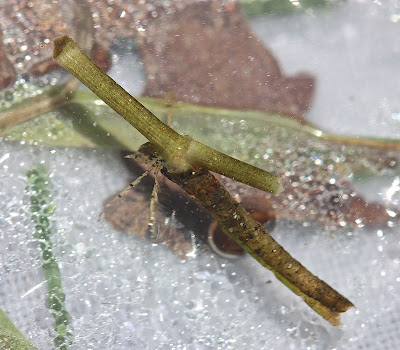Yesterday, I went to the Rivanna at Crofton, looking for dragons and damsels. I found some. But of greater interest to me was the little guy -- or gal -- in this picture. It's a "Long-horned" caddisfly larva: family -- Leptoceridae; genus and species -- Nectopsyche exquisita. I found 6-8 of these cases in a little more than ten minutes.
The name "long-horned" -- you may recall from a previous entry (1/26/11) -- refers to the length of the larval antennae. They are easy to see in this microscope photo. When you recall that the antennae of most caddisfly larvae are almost impossible for us to see -- even with high magnification -- these do indeed seem very long.
When they hatch, long-horned caddisflies are much loved by fly fishermen. I quote Thomas Ames: "The major gift of the order Trichoptera [caddisflies] to fly fishers of ponds and lakes is the family Leptoceridae. Known abroad as the silverhorns but domestically as the long-horned caddisflies, these small slender forms are also a key ingredient of river and stream hatches during the hot summer months." (Caddisflies: A Guies to Eastern Species for Anglers and Other Naturalists, p. 190.) He continues, "Larvae of all seven eastern genera are quite at home in warm ponds, marshes and lakes as well as in the softer currents in rivers and streams and especially where leafy aquatic plants can grow." The Rivanna at Crofton -- directly below the bridge -- has a fairly slow current before it spills over a series of rocks, it's filled with "leafy aquatic plants," and in the summer the water is warm: the perfect habitat for Leptocerids.
There are two genera that build this type of case -- Mystacides and Nectopsyche: it's a case that's not easy to see among the many green stems that rise up from the bottom. Again quoting from Ames, these two genera "...build cases with long sticks attached as a deterrent, not always successful, against predators. The added sticks often dwarf the case proper, making it difficult to locate in its natural surroundings."
The name of the fly that imitates Nectopsyche adults is the "White Miller," and fly fishermen would do well to read pp. 197-200 in Ames for information on the White Miller hatch.
Now, let's establish the genus and species ID using Steven Beaty's "The Trichoptera of North Carolina."
"Nectopsyche. Genus diagnosis: Hind tibia not secondarily divided; middle leg with slender, slightly curved claw; circularly roughened lateral hump with posteriorly directed sclerotized bar which is apically curved towards the venter." Let's look at the relevant microscope photos.
Hind tibia -- not divided:
Tarsal claw of middle leg -- slightly curved:
Lateral humps, with sclerotized bar pointing towards the stomach (venter):
In this last photo -- a ventral view of the larva -- also note the 8 setae (hairs) on the metasternum (the segment directly above the first abdominal segment). This is important for species ID.
And on we go to the species ID, again quoting from Beaty.
"N. exquisita -- larvae up to 13 mm; metasternum with 8 setae; dorsum of head mottled with combination of light spots surrounded by dark pigmentation and dark spots on a light background; middle and hind legs completely dark or with dark banding at joints. Case tubular and tapered, made mostly of plant and sand with plant stems extending from anterior end. Common and widespread." Ames also notes that "N. exquisita is the most common species of the southern states but is also well represented in the Northeast."
(Caddisflies, p. 200.)
Well, we've already seen the 8 setae, and the "dark banding at joints" that we find on the legs is very clear in the photo at the top of the page. The cases we found are as described. So, here is a close look at the mottled dorsum of the head.
Nectopsyche exquisita, and if you want to see them in our locale, go to the Rivanna -- especially the Rivanna at Crofton.
More photos from yesterday.
And in this last one, three of the larvae chose to gather together while swimming around.
For photos of adult Nectopsyche caddisflies, go to: http://bugguide.net/node/view/53447/bgimage. For adult Nectopsyche exquisita -- http://bugguide.net/node/view/53447/bgimage?from=48.











No comments:
Post a Comment